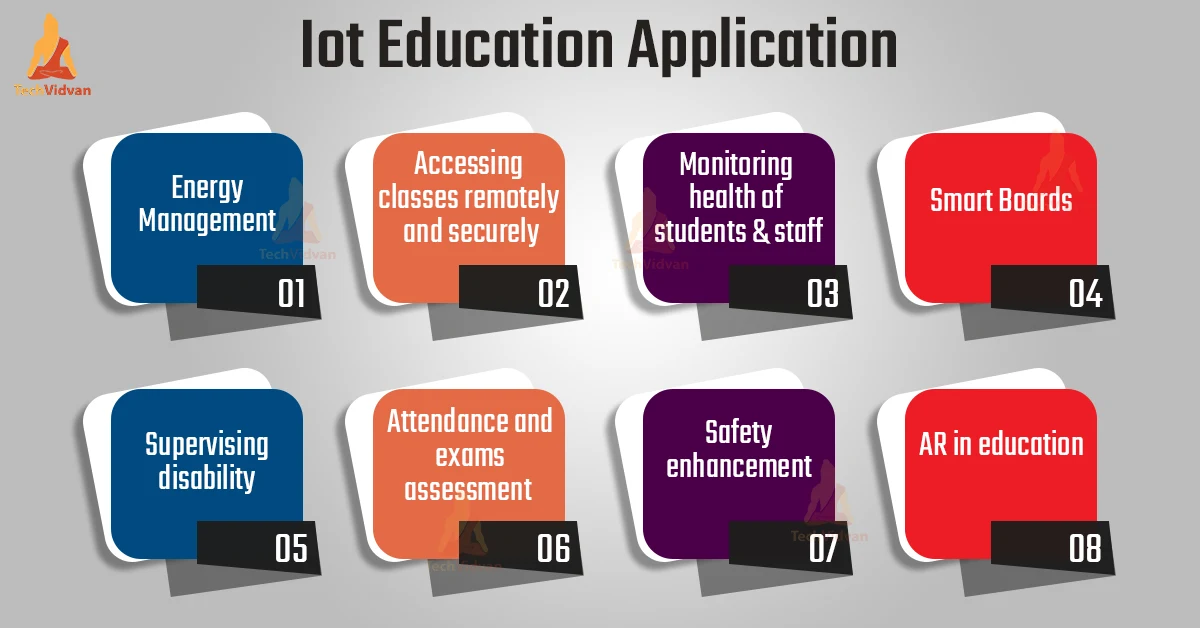The internet of things or the connection of devices other than the standard computers such as laptops and PCs is on the way to transform our lives completely in the coming years. Transformation of the educational sector through IoT is on that list. This transformation is further accelerating day by day. If you look around yourself, every student uses a smart device to connect to their school or any educational institute.
With the rise of technology, IoT allows educational institutes to increase safety in campuses, improve the quality of education, saves teachers from the tremendous paperwork and keep track of enrollments.
In this article we will study about the IoT applications in the educational sector.
What is the role of Iot in education?
According to a report by emarket retail, around 82 percent of kids between the age 12 to 17 have smart phones and they use these gadgets for educational and recreational purposes.
The upcoming generation is already attached to their phones and most of their activities depend on these phones.
There is concern for safety and protection of users but there is no doubt that IoT has so much potential to improve education.
You can view the application of IoT in educational institutes through two perspectives: teachers/staff and students’ perception.
Teachers can track their students’ attendance. Sensors in classes, libraries or canteens transfer student location or information to the teacher who can then assess student attendance accordingly.
The incorporation of IoT in classrooms helps teachers monitor the class virtually or remotely.
Implementation of IoT in Education Sector
1. Energy Management
- Rising global warming concerns call for reforms in the education sector to conserve the limited energy resources.
- Printing notebooks and textbooks in huge amounts lead to paper wastage.
Through IoT, textbooks are available in the electronic mode on devices for students to read and make changes. - Installing sensors and actuators in taps and lights so they automatically switch in the absence of human beings. IoT helps reduce harmful emissions such as CO2 and CO in the air.
2. Accessing classes remotely and securely
- IoT helps in creating a safe and secure environment for students. Most of the institutes globally switched to remote means of education and this was made possible through IoT.
- Sensors installed around the campus help monitor student activities and take action in case of bullying or damage to school property. RFID tags in students ID cards record attendances of students on a daily basis.
3. Monitoring health of students and staff
- Healthy students and staff means a more productive educational institute. It is important to ensure that students are taking care of their health and getting proper sleep every day so they are more active in class.
- Physiological signals detect and monitor student’s health. This information is stored in databases and it helps doctors analyse student health easily.
- IoT also helps in storing information such as blood pressure, medical history, allergies, prescription details to take necessary treatment in case of an unfortunate accident.
4. Applications to enhance interactive learning
Education can be made much more fun and interesting with the help of IoT. It keeps students engaging in knowledge and overall helps in building their personality and sharpens their minds.
- Even when a student is sick, learning can still continue through virtual classrooms on TVs and mobile phones.
- Learning becomes more interesting with Iot based graphic classrooms where textbooks are brought to life through 3D graphics, colours and noises.
- Applications such as voice-to-text converters help in taking down notes more effectively and easily.
5. Smart Boards
An electronic board or smart board is a great example of how Iot makes the job of teachers much easier and makes learning smoother.
- They are easy to use, reliable and student-friendly. It allows you to display images on the board and it helps you interact with the image.
- The board is a touch screen so you can manipulate the screen, move images around, draw graphics and so much more to personalize learning.
- Smart pens are used to draw and create 3D objects with colours and voices.
- Voice-to-text sensors convert teachers’ lessons into notes that are emailed to students directly.
6. Supervising disability
Children with disabilities such as dyslexia are often neglected while manufacturing educational tools. With IoT, special applications can be made that aid student learning for students with disabilities. Transcripts convert voice to sound so students with a hearing disability can read out the notes. Sound to voice aids students who cannot see. Special apps in tablets reform education for disabled students. These apps are analysed to assist learning.
7. Attendance and exams assessment
Certain institutions have rules in order for a student to pass such as maintaining 80 percent attendance to pass the semester and so on.
- IoT applications track student attendance and deliver reports to staff members.
- A message is sent to students with lower attendances and students can track their performance on applications developed through IoT technology.
- IoT makes it possible for students to take exams remotely. Sensors placed in devices can track student movement to ensure the student does not cheat.
8. Safety enhancement
In schools, technology and education go hand in hand. There are many IoT applications in school to help protect kids.
- These include fire detection sensors. Sensors alert the school premises and even go ahead and call the fire department in case of danger.
- Online activity monitoring to ensure students are not accessing explicit content in school premises.
- Video monitoring to keep track of student activities out of classes or during lunch breaks.
- Digital signage, access control, visitor management are other IoT applications to ensure school safety
9. AR in education
Augmented Reality is the technology that promotes live interaction and brings audios, videos and graphics to life. This helps students learn and understand the concepts better.
- Project mapping concepts in AR show the distances physically on the ground so students can perceive topics better.
- AR helps in creating interactive learning in classroom sessions and does not limit learning to only books and textbooks
10. Temperature Control in premises
Temperature requirements change in classrooms and gymnasiums
- IOT applications changes the temperature and light conditions according to the environment
- These application can also sense human presence and switch off or on the electricity accordingly
11. Real time data collection
- One of the biggest concerns of the current education system is that most of the syllabus and techniques of teaching are outdate now. Meaning, the topics do not fit well with the students of today.
- IoT helps in collecting data and performing analytics to produce topics that emphasize student interaction, build focus and promote learning on a much larger scale.
- IoT also helps in collecting data on information of staff and students to understand their likes and dislikes to improve production of school gadgets, accessories and information.
12. School Bus Safety
Parents have concerns sending their children to school through school buses dues to rash drivers and large amount of accidents involving school buses throughout the world
- IOT can help resolve this problem
- Drivers can use IOT applications to monitor the condition of the students on board
- School can track the driver and the bus from school premises
- Parents can check up on the location of their children to ensure they reach school safely and on time
- Speed limits, tire punctures can also be checked using IOT to raise alerts in case of danger.
13. Make sure kids get home safely
Many parents worry about their kids not being home on time or being lost on the way home from school. IoT is helping kids and parents by ensuring their kids arrive home on time.
- For example, sensors in school bags or school shoes send details and whereabouts of a kid’s location to their parents.
- This way parents can check up on their kids remotely. These IOT app raise alerts when the child is in danger
- These apps send location details to parents and to the nearby police departments as soon as the child goes out of the regular roads leading to home.
14. Educators
As important students are in the education system, teachers, tutors and professors are equally important.
- IoT helps ease the job of the teachers
- IoT applications take the attendance of the students, keep a track of their progress, list out the students based on different criteria such as grade, sports and so on.
- It is helping connect the gap between students and teachers by helping teachers understand better the needs of their pupils
15. Exam Surveillance
Examinations play a vital role in the success of a student. Hence, it is important to devise a mechanism that ensures that exams are conducted properly and in a fair manner.
- IoT is helping institutions in maintaining discipline during examinations.
- IoT embedded LED screens are helping detect faint noises and send alerts to the examiners.
- These devices display warning messages to students as well.
Advantages of IoT in Education
1. Efficient management of the school system: IoT is helping reduce the time and cost of spending money on manual work such as paper work, managing funds and tracking supplies.
2. Real-time information collection: IoT processes terabytes of data simultaneously. This data predicts and analyzes the activities of students and staff to build an efficient and reliable school system.
3. Improvisations in Resource Management: IoT is helping manage and rescue water and electricity consumption. The usage of paper has significantly reduced due to Iot systems in education
4. Global connections: Since Iot systems require the internet, it in a way connects and exposes you to school and universities globally. This gives you a platform to interact with global systems and improve the quality of education.
5. Includes Safety Concerns: Many parents living in rural areas worry about sending their kids to schools. Some may not be able to afford it while some may simply not have enough resources to fund a proper education. IoT is addressing such concerns and is making sure the child feels safe and secure while accessing quality education.
Drawbacks in involving IoT in education
1. High cost infrastructure: IoT managed systems cost high prices and are expensive to set up. It requires a large amount of software and hardware. It would require hiring a skilled team of IT officials to manage the school system.
2. In-class morals: IoT grades knowledges based test but there should be ways to prevent cheating, plagiarism or other kinds of fraud means to pass the test
3. Lack of data storage infrastructure: IoT requires large amounts of data processing information to be stored in the cloud. Old forms of data storing are not competent with IoT ecosystems.
4. Security and safety issues: IoT exposes private information to thousands of users online that can manipulate this information for their own benefits. IoT provides access to data and details of students and staff. Hackers get access to this sensitive data.
Summary
So in this article, we look at the various applications of IoT in the education sector. It is clear from the above applications that IoT has a high revenue generating future in the education sector.

